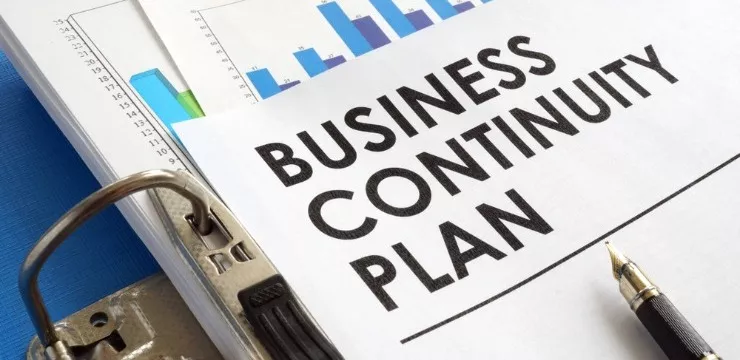
In today’s uncertain economy, a wide range of factors can disrupt normal business operations. Digital innovations, natural disasters, power outages, and many other disruptions can interfere with an organization’s ability to operate and deliver value to its customers.
To minimize the negative impacts of such disruptions, it is necessary to prepare for potential disasters and design contingency plans that allow businesses to continue operating normally.
In other words, it is necessary to develop a business continuity plan.
What Is a Business Continuity Plan?
A business continuity plan is a plan of action designed to help organizations minimize the effects of events that disrupt normal operations.
Such disruptions can include:
- Natural disasters
- Power outages
- Disruptions to the supply chain
- Data breaches, hacks, or digital disruptions
Business continuity plans define the types of disruptions that they are addressing, then outline a number of activities to undertake in such circumstances.
These can include:
- The creation of a business continuity team. During the event of a disruption, a specific team will usually be tasked with the implementation and management of the plan. The composition and size of the team will naturally vary, depending on the type of disruption, the scale of the organization, the industry, and other factors. Different types of disruptions will call for the inclusion of different specialties – IT disruptions, for instance, would require heavy support from IT teams.
- Training and exercises to help business continuity teams stay prepared. As the saying goes, “practice makes perfect,” which is why continuity teams should receive training before they actually implement a plan. Proper training and exercises, such as simulated drills, can improve their execution of a plan, reducing errors and improving the overall outcomes of the continuity efforts.
- Communication protocols. Communication strategies will address a number of areas. For instance, notification checklists describe a list of parties to contact during certain events. Templates and protocols can also be used to define which types of information is to be disclosed and when it should be disclosed.
- Remote working procedures and policies. Certain types of disruptions may impact employees’ ability to work on-site. In such instances, remote working policies may be a viable course of action. During the COVID-19 crisis, for example, many people were required to work from home – and organizations that had already developed telecommuting policies proved far more prepared than those that had not.
- Relocation procedures. Other types of disruptions, such as natural disasters, may require employees to relocate. Business continuity plans that address these types of disasters will explain how that relocation should take place, when it should occur, which business units should relocate to which locations, and other relevant actions that must occur.
- Recovery and restoration. In many cases, organizations will need to rebuild or restore their previous systems and activities. Business continuity plans should explain these recovery procedures in detail, outlining what needs to be restored, where these activities will take place, a timeline of events, roles and responsibilities, and so forth.
- Evaluation and assessment of business continuity activities. Once a business continuity plan has been implemented, it should be reviewed and analyzed. Status reports, event logs, analytics, and other data sources can all be compiled and used to gain insight into the performance of the continuity efforts.
The more detailed the plan, the more prepared an organization will be in the event of actual disruptions to the business.
Naturally, it would be better to never have to use them – but if a disruption does occur, it is far better to be ready than it is to be unprepared.
Why Are Business Continuity Plans Important?
Having and executing a business continuity plan offers several advantages to organizations:
- Organizations will have a predetermined course of action that they can follow in the event of a disruptive change, which saves time and prevents them from having to create one after disruptions occur
- Continuity plans minimize disruptions’ effects on business operations, the customer experience, employees, and the bottom line
- Well-executed business continuity efforts can help organizations restore normal operations more quickly and more effectively
- Certain industries, such as the financial industry and the healthcare industry, have regulations and laws that require organizations to maintain business continuity plans
- Having business continuity plans in place can instill trust into customers, improving the organizations reputation
- Some vendors and business partners require that organizations maintain business continuity plans
There are clearly many reasons to develop business continuity plans, so when and where possible, organizations should prepare for business disruptions well before they occur.
How Do You Design a Business Continuity Plan?
There are several steps to follow when designing a plan:
- Assess the potential impact of different types of disruptions to the business
- Defining which business functions should be prioritized and maintained during the event of a disruption
- Outlining a course of action to take when a certain type of disruption occurs
- Training employees and creating a business continuity team
Plans may change as they are implemented, which is only natural – after all, it is impossible to predict how certain scenarios may play out in the real world. However, as we saw earlier, having a business continuity plan can provide so many benefits that there is little reason not to have one.
WalkMe Team
WalkMe spearheaded the Digital Adoption Platform (DAP) for associations to use the maximum capacity of their advanced resources. Utilizing man-made consciousness, AI, and context-oriented direction, WalkMe adds a powerful UI layer to raise the computerized proficiency, everything being equal.



